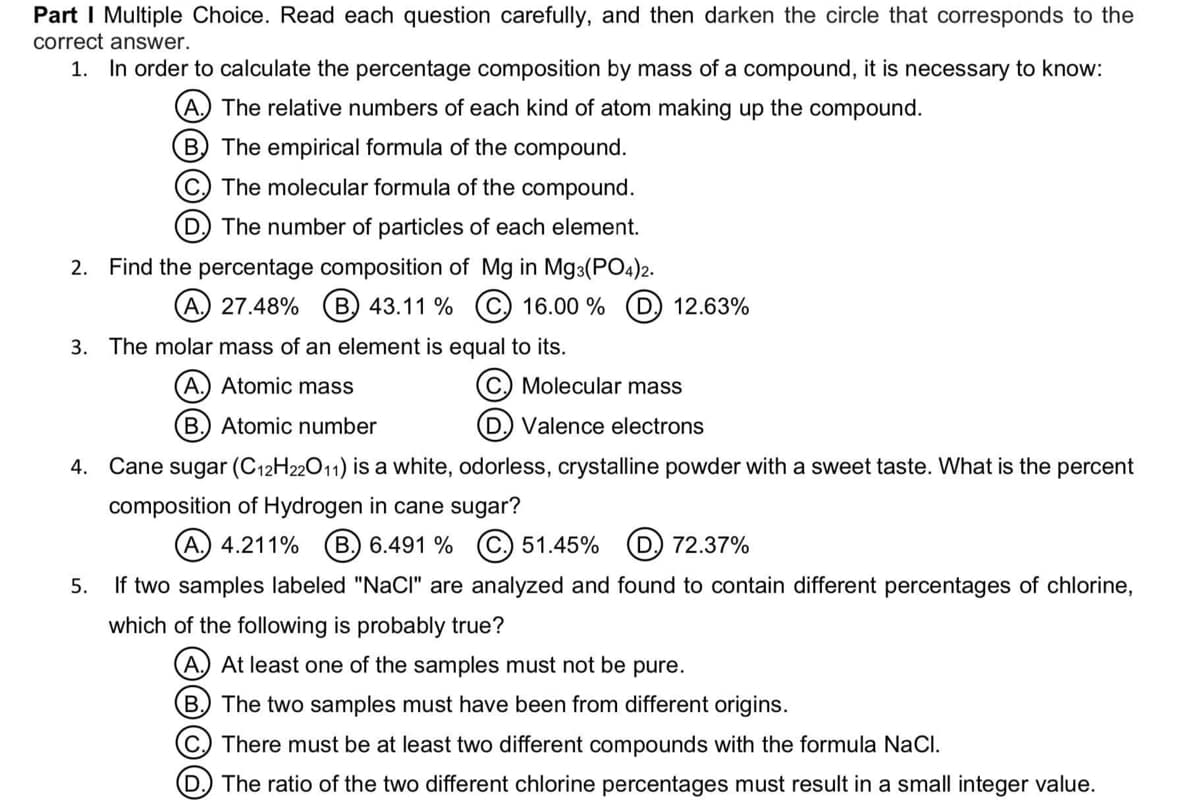In order to calculate the percentage composition by mass of a compound, it is necessary to know: (A.) The relative numbers of each kind of atom making up the compound. B The empirical formula of the compound. The molecular formula of the compound. The number of particles of each element.
In order to calculate the percentage composition by mass of a compound, it is necessary to know: (A.) The relative numbers of each kind of atom making up the compound. B The empirical formula of the compound. The molecular formula of the compound. The number of particles of each element.
Introductory Chemistry: A Foundation
9th Edition
ISBN:9781337399425
Author:Steven S. Zumdahl, Donald J. DeCoste
Publisher:Steven S. Zumdahl, Donald J. DeCoste
Chapter8: Chemical Composition
Section: Chapter Questions
Problem 93AP: Find the item in column 2 that best explains or completes the statement or question in column 1. l...
Related questions
Question

Transcribed Image Text:Part I Multiple Choice. Read each question carefully, and then darken the circle that corresponds to the
correct answer.
1. In order to calculate the percentage composition by mass of a compound, it is necessary to know:
A The relative numbers of each kind of atom making up the compound.
B The empirical formula of the compound.
C. The molecular formula of the compound.
D, The number of particles of each element.
2. Find the percentage composition of Mg in Mg3(PO4)2.
A.) 27.48%
B. 43.11 % C 16.00 %
12.63%
3. The molar mass of an element is equal to its.
A.) Atomic mass
Molecular mass
B. Atomic number
D. Valence electrons
4. Cane sugar (C12H22011) is a white, odorless, crystalline powder with a sweet taste. What is the percent
composition of Hydrogen in cane sugar?
(A. 4.211%
B.) 6.491 % (C.) 51.45% (D) 72.37%
5. If two samples labeled "NaCl" are analyzed and found to contain different percentages of chlorine,
which of the following is probably true?
A.) At least one of the samples must not be pure.
B) The two samples must have been from different origins.
C) There must be at least two different compounds with the formula NaCI.
D) The ratio of the two different chlorine percentages must result in a small integer value.
Expert Solution
This question has been solved!
Explore an expertly crafted, step-by-step solution for a thorough understanding of key concepts.
This is a popular solution!
Trending now
This is a popular solution!
Step by step
Solved in 2 steps with 2 images

Knowledge Booster
Learn more about
Need a deep-dive on the concept behind this application? Look no further. Learn more about this topic, chemistry and related others by exploring similar questions and additional content below.Recommended textbooks for you

Introductory Chemistry: A Foundation
Chemistry
ISBN:
9781337399425
Author:
Steven S. Zumdahl, Donald J. DeCoste
Publisher:
Cengage Learning

World of Chemistry, 3rd edition
Chemistry
ISBN:
9781133109655
Author:
Steven S. Zumdahl, Susan L. Zumdahl, Donald J. DeCoste
Publisher:
Brooks / Cole / Cengage Learning

Introductory Chemistry: A Foundation
Chemistry
ISBN:
9781285199030
Author:
Steven S. Zumdahl, Donald J. DeCoste
Publisher:
Cengage Learning

Introductory Chemistry: A Foundation
Chemistry
ISBN:
9781337399425
Author:
Steven S. Zumdahl, Donald J. DeCoste
Publisher:
Cengage Learning

World of Chemistry, 3rd edition
Chemistry
ISBN:
9781133109655
Author:
Steven S. Zumdahl, Susan L. Zumdahl, Donald J. DeCoste
Publisher:
Brooks / Cole / Cengage Learning

Introductory Chemistry: A Foundation
Chemistry
ISBN:
9781285199030
Author:
Steven S. Zumdahl, Donald J. DeCoste
Publisher:
Cengage Learning


Chemistry for Engineering Students
Chemistry
ISBN:
9781337398909
Author:
Lawrence S. Brown, Tom Holme
Publisher:
Cengage Learning

Chemistry: Matter and Change
Chemistry
ISBN:
9780078746376
Author:
Dinah Zike, Laurel Dingrando, Nicholas Hainen, Cheryl Wistrom
Publisher:
Glencoe/McGraw-Hill School Pub Co